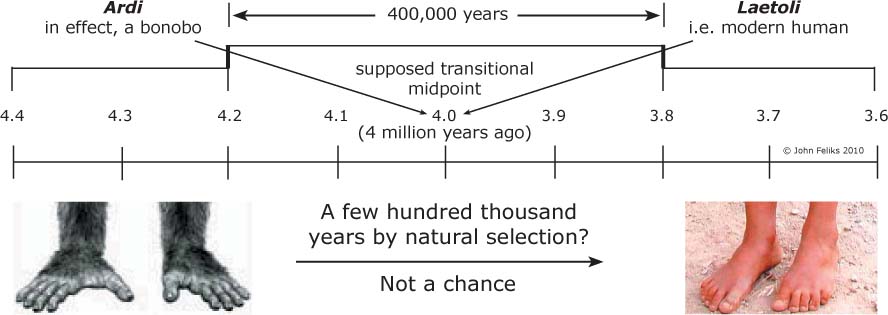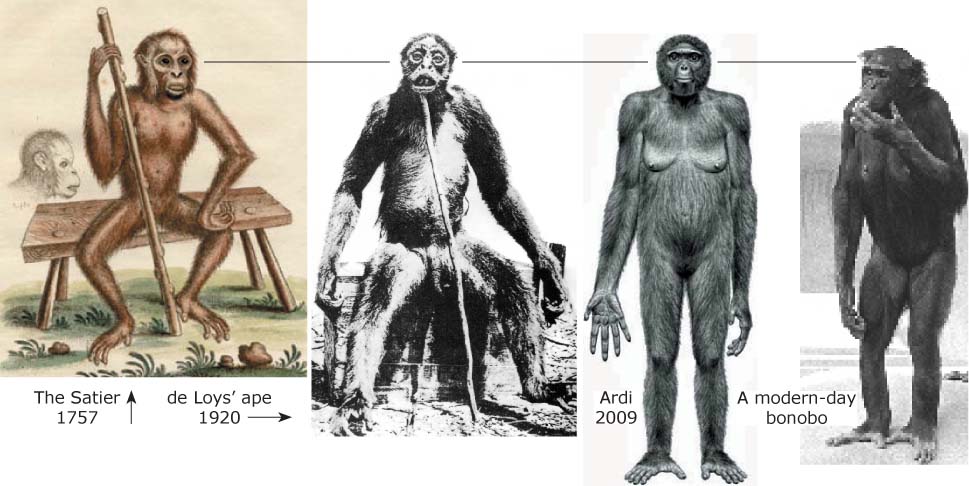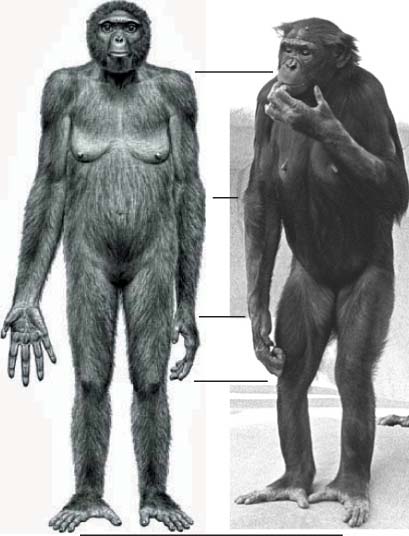 So, these opinions bring up a reasonable question. How long is a “very long period of time”?
So, these opinions bring up a reasonable question. How long is a “very long period of time”?
Return to Phi in the Acheulian

It is quite interesting that comments such as this one from the October issue of Science no longer raise a question mark in the public’s mind despite what anyone can see with their own eyes.
But this was par for the course in 2009, the 200th birthday celebration of Charles Darwin. It was the year in which Darwinian anthropology made its most concerted effort ever to promote an ideology rather than simply report the facts.
The “great discovery,” as it was called, was, in reality, a carefully-manufactured mythological being. And the idea, of course, was the usual evolution-by-natural-selection in which all species come about from one another through infinitesimal changes over time. The idea has always been plagued with factual and mathematical problems, but has reached a pinnacle in Ardi.
Still, Ardi's debut came through a flood of media hype and full uncritical support of the American Association for the Advancement of Science (AAAS). This prompts the question, is it good science to so boldly promote an idea which can never be tested in real time?
In this article, I will answer that question: Firstly, I will explain the humanization of apes by science. Secondly, I will examine the ‘coelacanth problem’ or why it was necessary to downplay Ardi’s obvious similarity to the bonobo, and lastly, I will show how the tenacity of Darwinian thinking has finally backed itself into a factual and mathematical corner.
Ape
humanization is much easier to accomplish with an artistic rendition,
such as that of Ardi or the Satier than with a photograph, as the above
four strikingly similar images attest (Fig.1).
Yet, Swiss geologist Dr Francois de Loys’ South American ape (or spider monkey as some assert) represented by an actual photograph is the only one of these images of which its detractors have gone so far as to call an ape-man hoax and declare Dr. de Loys a fraud.
Page 1
 A
new and strangely human species of the anthropoid apes.”
A
new and strangely human species of the anthropoid apes.”
Claims such as these are regularly produced in anthropology and are usually later backed-down from, retracted, or disproved.
Of the four images in Figs. 1 & 2, the only one which is completely free from the possibility of being false is the photograph of the modern-day bonobo taken by esteemed primatologist, Frans de Waal (image cropped with permission).
Even though artistic renditions such as Ardi are only interpretations, often the idea of an interpretation falls by the wayside due to faith in a paradigm; and soon an impressionable audience is given a full-fleshed Ardi complete with human features and presented as “scientific fact.”
The way Ardi was presented gave the impression that human features just fell into place based on the physical evidence.
Fig. 2. Ardi illustration, J. H. Matternes; Bonobo photograph, Frans de Waal.
CALLOUT QUOTE
“Bonobos are not on their way to becoming human any more than we are on our way to becoming like them.”
-primatologist, Frans de Waal, Bonobo: The Forgotten Ape
Proponents of Ardi and sceptics alike have called the resulting creature, with its odd mixture of ape and human traits, “bizarre.” Yet few question it. Why?
Unlike Ardi, de Waal’s bonobo photograph (Fig.2) is completely objective. Though it resembles Ardi, no one calls it “bizarre,” as de Waal is not attempting to pull more out of the bonobo than is actually there. De Waal’s photograph shows beyond doubt that Ardi is not unique. So, rather than add human features that make Ardi look “bizarre,” truly objective science would let her remain an ape.
But here is the problem. If the Ardi scientists admit Ardi’s similarity to the bonobo it would go straight against the very reason she was hyped in the first place. This is because Ardi is not simply a fossil being objectively presented to the public as one would expect from other scientific fields; she is an “image” created to promote an ideology.
With evidence as unambiguous as Dr. de Waal’s bonobo photograph, no scientist would attempt to convince the world that bonobos have fully-human posture or that they can walk in a near-human fashion. Nor would they suggest that such creatures will eventually evolve into humans as de Waal himself points out: “Bonobos are not on their way to becoming human any more than we are on our way to becoming like them.”
But attempting to convince is exactly what the Ardi team has done. Working to convince rather than prove is quite common in evolutionary anthropology where evidence can never be tested in real time but where the stakes of public interest are high.
“Whereas
the chief anthropologist on the Ardi team goes by the bonobo-like name
of Owen Lovejoy, he focuses all of this attention on the
chimpanzee...Since chimps are violent and Ardi probably wasn't, he
argues that we have a totally unique creature on our hands.”
-Frans de Waal, primatologist
As the coelacanth taught us early in the 20th century, it is difficult to use a fossil as a transitional evolutionary link if a living example happens to one day show up. So, in the case of Ardi now is apparently just not the time to look at the bonobo. It is an example of how science, when it gets involved in promoting ideologies instead of discoveries tends to downplay certain kinds of evidence or even block it from being published (behaviours in science which, incidentally, inspired the formation of the Pleistocene Coalition).
To admit the obvious similarity between Ardi and the bonobo would undermine Ardi’s use as a transitional link and show her to simply be an ape hardly changed in 4.4 million years.
In
fact, the only differences between Ardi and the bonobo which can be
seen in Fig.2 are added human traits, none of which are deducible from
the fossils.
Page 2
So, has an accurate image of Ardipithecus been presented to the public? Definitely not.
But this is not unusual in evolutionary anthropology. Although the whole idea of bipedal apes has reached its apex with Ardi, it received its biggest boost during the late Seventies when scientists commandeered for Australopithecus, another early ape (e.g., “Lucy”), the essentially modern-type Laetoli footprints (3.6—3.8 million years old) despite no direct association between them. Circumstantial claims such as this would never be accepted in sciences where rigor is the rule.
Yet the scientific community has unabashedly perpetuated the myth that australopithecines had modern feet ever since. It simply added ‘australopithecine bipedality’ to a bank of “facts” which have, similar to many others in the Darwinian system, never been proven as facts to begin with.
The
problem with doing science this way is that future researchers tend to
build on prior-established facts. Building on facts that are not facts
at all is not the best way to go.
CALLOUT QUOTE
“The only thing detracting from the tidy picture in the film's depiction is that troublesome grasping toe.”
The
figure below (Fig.3) shows the time-frame defaulted to by the Ardi team
during which ape feet are supposed to have changed into human feet by
the slow process of natural selection. When species overlap in time, it is difficult to imagine one
as an ancestor of the other. The real problem is made clear when
scientific opinions on the nature of feet and footprints are compared
with the numbers.
Back when Ardi team co-leader, Tim White, was promoting Australopithecus as a bipedal human ancestor, he had this to say about the Laetoli footprints:
“Make no mistake about it. They are like modern human footprints”
-Tim White, Lucy: The Beginnings of Humankind.
As to how long it took for such ‘modern feet’ to become modern, the Ardi team’s bipedality expert, Owen Lovejoy, said that the Laetoli footprints are what one would expect in “a biped that had been that way for a very long period of time.” -Owen Lovejoy, NOVA: In Search of Human Origins
 So, these opinions bring up a reasonable question. How long is a “very long period of time”?
So, these opinions bring up a reasonable question. How long is a “very long period of time”?
According to footprint expert, Louise Robbins, of the original Laetoli team (along with Mary Leakey who regarded Laetoli as representing humans rather than apes), the Laetoli hominid-type had been walking erect for “at least a million years” (Lucy: The Beginnings of Humankind). If we give Robbins’ and Leakey’s expertise any credence, then this certainly creates a problem as it would mean that humans were here 4.8 million years ago, that is, 400,000 years before Ardi… our supposed ancestor.
Even if we took Lovejoy’s comment to mean something more on the order of only several hundred thousand years, then feet of a modern type were around virtually at the same time as Ardi (4.2 to 4.4 million yrs ago). That wouldn’t even leave any natural-selection tweaking time between Ardi and Laetoli.
In other words, modern human feet and those like Ardi or bonobos have clearly remained unchanged, side-by-side, for over four million years.